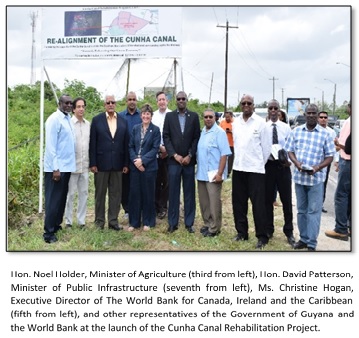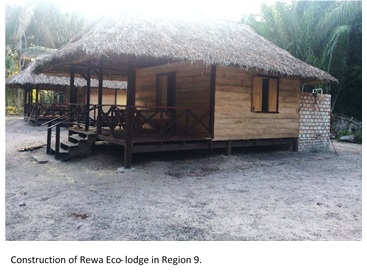Info
Cunha Canal
- Published: 12 January 2012
- Hits: 12512

Quick Facts
Total Project Budget: US$ 3 Million
Partner Entity:
Implementing Agency: Ministry of Agriculture
Project Background and Summary
The Cunha Canal Rehabilitation Project i s a part of Guyana’s adaptation initiatives. The proposed physical works for the Cunha Canal will include the widening of the canal, the rehabilitation of the former outlet structure, rerouting the canal to re-establish its original alignment and construction of a bridge on the East Bank of Demerara Public Road where the canal intercepts the road. Rehabilitation of the Canal will increase its discharge capacity and contribute to reducing the risks of the embankment overtopping and flooding of areas along the East Bank of the Demerara. It is estimated that 39% of Guyana’s population and 43% of GDP are in regions exposed to significant flooding risk, and extreme weather events are increasing in frequency – in 2005 floods caused losses equivalent to 60% of Guyana’s GDP. The Cunha Canal project is seen as one of the major adaptation projects aimed at a more climate resilient economy in Guyana. The rehabilitation of the Cunha Canal is expected to reduce flooding in neighbouring communities on the East Bank of Guyana, potentially restore productive use if farmlands, previously flooded in those communities, and improve dam stability in the south western section of the larger East Demerara Water Conservancy (EDWC).
Rehabilitation of the Canal will increase its discharge capacity and contribute to reducing the risks of the embankment overtopping and flooding of areas along the East Bank of the Demerara. It is estimated that 39% of Guyana’s population and 43% of GDP are in regions exposed to significant flooding risk, and extreme weather events are increasing in frequency – in 2005 floods caused losses equivalent to 60% of Guyana’s GDP. The Cunha Canal project is seen as one of the major adaptation projects aimed at a more climate resilient economy in Guyana. The rehabilitation of the Cunha Canal is expected to reduce flooding in neighbouring communities on the East Bank of Guyana, potentially restore productive use if farmlands, previously flooded in those communities, and improve dam stability in the south western section of the larger East Demerara Water Conservancy (EDWC).
Status Update
The operations manual and procurement plan for the project have been completed and approved by the Partner Entity, the World Bank.
With respect to the works to be completed, the bills of quantities and designs for the drainage channel, the outlet structure at the EDWC, and public road bridge have been completed, leaving just the bills of quantities and designs for the outlet structure at the Demerara River to be completed.
Additionally, recruitment is in advanced stages for the hiring of a Social Specialist and an Environmental Specialist under the project.
It is expected that the tender processes for major works, goods, and services will commence in April 2017.
Documents/Attachments
- Cunha Canal Project Concept Note
- Record of Decision - GRIF Steering Committee Approval for Project Concept Note
- Cunha Canal Project Document
- Record of Decision – GRIF Steering Committee Approval for Project Document
- Abbreviated Resettlement Plan
- Environmental and Social Assessment Report
________________________________________________________________________________
Partner Entities
- Inter-American Development Bank
- United Nations Development Programme
- United Nations Environmental Programme
- Food and Agriculture Organisation of the United Nations
- World Bank
Implementing Agencies
- Small Business Bureau - Ministry of Business
- Ministry of Agriculture
- Ministry of Indigenous Peoples’ Affairs
- Guyana Forestry Commission
Contact Us: Low Carbon Development Strategy
GRIF Operational Manual
- Published: 13 September 2011
- Hits: 17524
Micro and Small Enterprise Development
- Published: 19 August 2011
- Hits: 26700
Project Timeline

Quick Facts
Total Project Budget: US$ 5 Million
Partner Entity: 
Implementing Agency: Small Business Bureau, Ministry of Business
Project Background and Summary
This Micro and Small Enterprise Development (MSE) Project aims to address two of the major bottlenecks that constrain the development of MSEs and the ability of vulnerable groups to build alternative livelihoods in Guyana, which are i) limited access to finance and ii) limited technical and business skills.
Access to finance is addressed through a credit guarantee facility; an interest payment support facility; and a low carbon grant scheme to assist vulnerable persons with viable business propositions in low carbon sectors. The Small Business Bureau works with Partner Financial Institutions, currently Republic Bank Ltd. (RBL), Guyana Bank for Trade and Industry (GBTI), and the Institute for Private Enterprise Development (IPED), to facilitate the loan process. With respect to the commercial banks, RBL and GBTI, that are Partner Financial Institutions, the Government of Guyana has granted concessions to these institutions under the project to reduce interest rates to 6% for all loans under the MSE project.
Lack of skills is addressed through a training voucher scheme which will enable MSEs to obtain the skills they require at existing training institutions free of cost to them. The project targets MSEs who are in or who wish to transition to low carbon sectors.
The low carbon sectors identified for funding under the project are: fruits and vegetables (farming and processing); aquaculture; eco-tourism; business process outsourcing; bio-ethanol; energy efficient transportation and logistics; low carbon manufacturing activities; low carbon agriculture and agro-processing; apiculture; low carbon energy production and/or distribution; professional and business services; internet and computer based services; entertainment, music and performing arts; arts and crafts; and publishing and printing.
Status Update
Under the MSE project two hundred and twenty four (224) loans were approved for beneficiaries in low carbon sectors at a total approximate value of US$ 4,399,138 (G$ 908,422,000). Under the grant component of the project five hundred and tninety one (591) grants were approved for entrepreneurs, including those from vulnerable groups, under the project at an approximate value of US$ 891,055 (G$ 184,002,830). It is estimated that approximately two thousand one hundred and one (2,101) jobs have been created and or sustained from these loans and grants.
Additionally, four thousand four hundred and eighty two (4,482) persons were trained free of cost in several areas, including: basic business management skills, record keeping, packaging and labelling, a special course aimed at female entrepreneurs, climate smart agriculture, sustainabale forestry, sustainable mining, videography, photography, cosmetology, cookery, and craft.
Relevant Documents
 MSE Project Concept Note
MSE Project Concept Note MSE Admin Fees Request
MSE Admin Fees Request MSE Project Concept Note - Record of Decision
MSE Project Concept Note - Record of Decision MSE Project Document Final
MSE Project Document Final MSE Project Document - Record of Decision
MSE Project Document - Record of Decision MSE Mid-term Evaluation
MSE Mid-term Evaluation
________________________________________________________________________________
| Partner Entities | Implementing Agencies |
| Inter-American Development Bank | Small Business Bureau - Ministry of Business |
| United Nations Development Programme | Ministry of Agriculture |
| United Nations Environmental Programme | Ministry of Indigenous Peoples’ Affairs |
| Food and Agriculture Organisation of the United Nations | Guyana Forestry Commission |
| World Bank |
Low Carbon Development Strategy
Summary Status of GRIF Projects
- Published: 19 August 2011
- Hits: 27378
Amerindian Development Fund
- Published: 19 August 2011
- Hits: 23227
Project Timeline

Quick Facts
Project Budget: US$ 8.1 Million
Partner Entity: ![]()
Implementing Agencies: Ministry of Amerindian Affairs
Project Background and Summary
The Amerindian Development Fund was established to provide funding to support the socio-economic development of Amerindian communities and villages,  through the implementation of their Community Development Plans (CDPs). The project aims to strengthen the entrepreneurial and institutional capabilities of the village economies of Amerindian communities; improve linkages with the private sector to further develop value chains; and strengthen institutional frameworks to support local economies. CDPs being implemented by communities and villages cover projects in the following sectors: agriculture, village infrastructure, tourism, manufacturing, village business enterprise, and transportation.
through the implementation of their Community Development Plans (CDPs). The project aims to strengthen the entrepreneurial and institutional capabilities of the village economies of Amerindian communities; improve linkages with the private sector to further develop value chains; and strengthen institutional frameworks to support local economies. CDPs being implemented by communities and villages cover projects in the following sectors: agriculture, village infrastructure, tourism, manufacturing, village business enterprise, and transportation.
Status Update
Phase 1 of the Amerindian Development Fund (ADF) realised the provision of funding to twenty 26 communities and villages in the amount of US$ 753,857 (G$ 155,671,470) for the implementation of their Community Development Plans. Additionally, capacity development of the Ministry of Indigenous Peoples’ Affairs was conducted following an initial assessment of relevant areas prior to the start of this initial phase.
Phase 2 of the ADF project ensured to incorporate key lessons learned from Phase 1 for greater project efficiency, as well as impact and sustainability of CDPs. Some of those lessons, at a high level summary, included the following considerations: (i) Community ownership and participation is fundamental to the preservation and respect for Amerindian rights, traditional knowledge and practices, and the implementation of this project; (ii) Development of the village economy is critically linked to clustering, marketing, availability of economic opportunities, and other industry linkages, inter alia; (iii) Modalities for the disbursement of funds should be mindful of risks, costs and delays in situations where communities cannot use bank accounts; (iv) access to and cost of energy; and (v) logistical costs, risks, weather, and mitigation measures should be fully considered in the planning and delivery of project activities.
Under Phase 2 of the ADF project approximately US$ 3,658,663 (G$ 755,513,945) was disbursed to one hundred and fifty three (153) communities/villages for the implementation of their Community Development Plans. One hundred and fifty four (154) communities and villages have benefitted from leadership and business management training for their CDP Management Teams and cluster training sessions were conducted in, among other things, cattle management, fish culture, wood working, and business operations. Furthermore, work was completed to improve linkages with the private sector to further develop value chains and to strengthen the institutional framework to support local communities.
The Amerindian Development Phase 2 project has been completed and closed.
Documents/Attachments
 Amerindian Development Fund Phase 1 Project Concept Note
Amerindian Development Fund Phase 1 Project Concept Note Record of Decision – GRIF Steering Committee Approval for Project Concept Note
Record of Decision – GRIF Steering Committee Approval for Project Concept Note Partner Entity Fee Request
Partner Entity Fee Request Amerindian Development Fund Phase 2 Project Document
Amerindian Development Fund Phase 2 Project Document Record of Decision for Phase 2 Project Document
Record of Decision for Phase 2 Project Document Amerindian Development Fund Phase 1 Final Evaluation
Amerindian Development Fund Phase 1 Final Evaluation Amerindian Development Fund Phase 2 Mid-Term Evaluation
Amerindian Development Fund Phase 2 Mid-Term Evaluation Amerindian Development Fund Operations Manual
Amerindian Development Fund Operations Manual
________________________________________________________________________________
| Partner Entities | Implementing Agencies |
| Inter-American Development Bank | Small Business Bureau - Ministry of Business |
| United Nations Development Programme | Ministry of Agriculture |
| United Nations Environmental Programme | Ministry of Indigenous Peoples’ Affairs |
| Food and Agriculture Organisation of the United Nations | Guyana Forestry Commission |
| World Bank |
